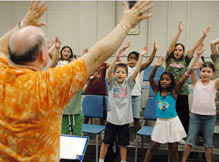By Cindy Reed/reporter
(Final in a three-part series on the Sandwich Generation—when the role of family members changes to accommodate children and elder parents.)

Rita Langston should have gotten “frequent driver miles” credit toward a luxurious vacation when she cared for her parents and her aunt as a single mother of three teens.
Langston lived in Desoto and commuted to Dallas to fulfill her family obligations.
An administrative assistant on NE Campus, Langston cared for both her parents and her mother’s twin sister until their deaths.
Langston is one of the baby boomers who make up approximately 28 percent of the total U.S. population.
Medical and scientific advances mean people will live longer though this does not guarantee a high quality of life.
Many who could not have survived chronic medical conditions 20 years ago now require a great deal of long-term care, whether attended by family members or in a long-term care facility.
Before he suffered massive head injuries in a car wreck, Langston’s father was a handsome, robust Texas rancher.
After his accident, he, his wife and her sister moved together into an “independent living” facility in Dallas.
Their circumstances changed and health deteriorated, so Langston split her time among her mother in a Dallas hospital room, her father in a Dallas nursing home and her aunt in the independent living facility.
She was trying to be there for her own kids as well.
Langston struck a better arrangement when she moved into a Grapevine home. Her mother and aunt moved to a nearby assisted living facility, and her father went to a Grapevine nursing home.
Langston’s situation is not unique, U.S. residents over the age of 65 reached 35 million by the year 2000, or equal to roughly 12 percent of the total population.
By 2030, the population 65 years of age and older will more than double to approximately 72 million people, and by 2040, 80 million Americans will have reached and surpassed traditional retirement age, Dr.
Laura Overstreet, chair of the sociology/psychology department on NE Campus, said.
“ The baby boomers will soon present a two-fold problem. There will be fewer nurses to care for this aging segment of the population because the majority of nurses currently working in the healthcare industry are themselves boomers and will be retiring,” she said.
Secondly, as more than a quarter of the entire population retires, the older population will require more of the healthcare system as part of the aging process.
Serving as a surrogate care provider, Langston recalled a shopping trip when her mother, eager to test drive the electric cart provided by the store, crashed into a display of green beans.
“ Even though she was embarrassed, we both had to laugh,” she said. “I’m sure we stopped traffic more than once.”
Although in their 90s, the twins had great energy.
“ Even though my aunt was blind, that didn’t slow her down crossing the street, with my mother bringing up the rear using her walker. I was trying to keep up with them both,” Langston said.
According to the Medicare Web site, Medicare does not generally pay for long-term “custodial care.” Custodial care (non-skilled care) is defined as care that helps with activities of daily living.
Sixty to 70 percent of aging Americans will require long-term care, usually occurring in the home, and usually provided by a female family member, including in-laws, Overstreet said.
The debate continues as to whether Medicare will survive to assist baby boomers, with the large percentage of the population calling upon the system’s assistance but not contributing via tax contributions.
Turning 65 does not mean one is automatically old or feeble.
Those persons considered relatively healthy, between the ages of 64 and 74, are the “young old” and report little change in lifestyle from their middle-aged years, Overstreet said.
The “middle old,” those people between the ages of 76 and 84, predictably report increasing illness and dependence upon others.
While the “truly old” represent people from 85 onward, those surpassing the age of 100 are also growing significantly, Overstreet said.
Langston’s father lived about nine years after his accident. She often wanted to put a picture of her father in his room as he was before the wreck to let his caregivers know that the person they saw before them was not the vital man who was her father.
The best prescription for aging Americans to increase their longevity while maintaining their quality of life is the early promotion of healthy lifestyles before they become feeble, Overstreet said.
Positive lifestyle changes include attention to general health and mental well being, proper nutrition, exercise and an active lifestyle.
For more information, visit online at www.medicare.gov/LongTermCare/Static/Home.asp.























